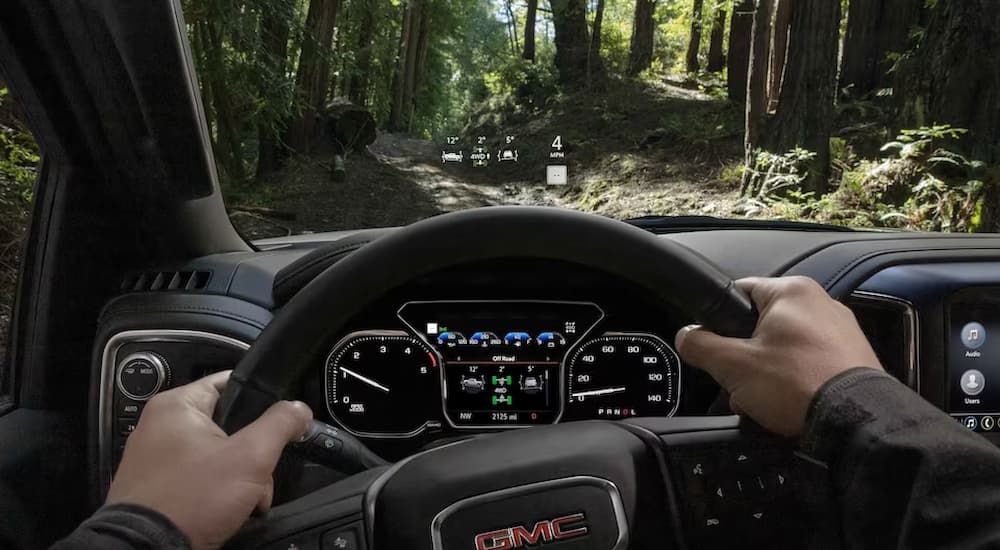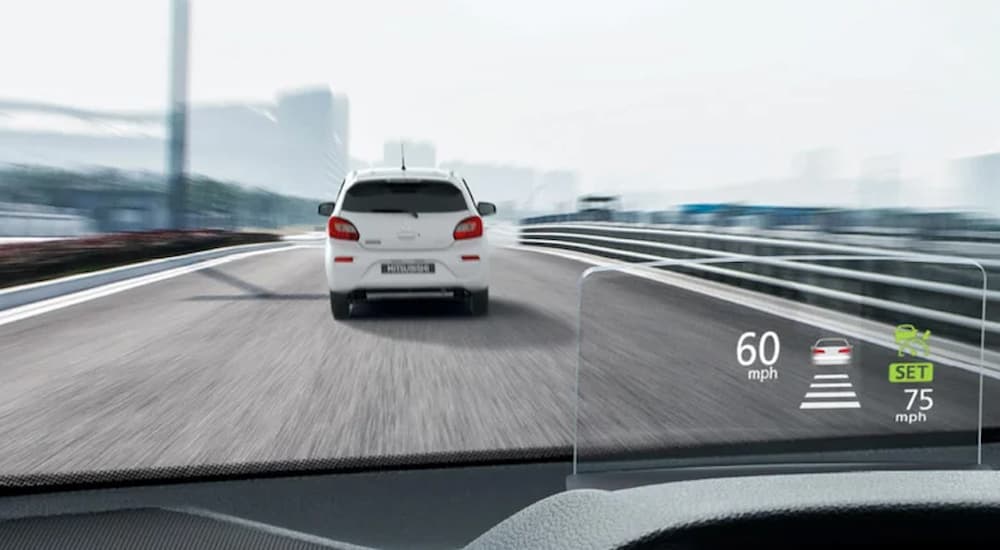From countless sci-fi spaceships to the very literal versions sported by the likes of Iron Man, the Predator, and Arnold Schwarzenegger’s T-800, few pieces of tech so well encapsulate cutting-edge futurism as a head-up display. The ability to see relevant driving stats projected directly into your field of vision can make any car, truck, or SUV feel like an artifact from a galaxy far, far away—which is probably why they’re such a popular feature in many of today’s vehicles.
First debuting on high-end luxury models from the likes of Audi, Mercedes-Benz, Lexus, and Infiniti, head-up displays (HUDs) are now a common add-on across much of the market. These displays make it easy for drivers to gauge their speed, view turn-by-turn GPS directions, or even monitor fuel economy without ever taking their eyes off the road, conferring some real benefits in convenience and safety. These HUDs are particularly useful for monitoring many of today’s advanced driver assistance systems (ADAS) and autonomous driving systems.
It certainly seems like HUDs are going to become an increasingly common feature on new models, but what if you’re not in the market for a new vehicle or your preferred make or model isn’t offered with a HUD as either a standard or optional feature? That’s where aftermarket solutions come in. Over the last few years, these aftermarket HUD systems have become a popular upgrade for drivers looking to modernize their rides.
But choosing an aftermarket HUD isn’t as easy as shopping around for the slickest design. From display type and compatibility to price and features, there are lots of factors to keep in mind when you’re on the hunt for an aftermarket HUD. We’ve compiled a quick guide to address some of these intricacies and collected a short list of some of our favorite products currently on the market, so read up and see how easy it can be to turn your daily driver into something straight out of a sci-fi blockbuster.
Projection vs Reflection
When choosing an aftermarket HUD, the first variable you’ll have to consider is whether to go with a projection- or reflection-based model. The former uses a projector to display information on a screen that’s typically attached to the base of your windshield, while the latter simply reflects a standalone display.
On some higher-end models, this might take the form of a dedicated display, but more often than not, they simply reflect the screen of a driver’s smartphone that’s running a HUD app onto a transparent screen or a clear film adhered to the windshield. There are also a number of so-called HUDs, which really amount to little more than an LCD screen that can be mounted to the dashboard; while these can also give drivers easy access to important driving information, the lack of transparency disqualifies these products as true HUDs in our opinion.
Reflection-based HUDs are often seen as inferior to the projection version for a number of reasons. The first is visibility; a reflection-based HUD might work fine when you’re driving at night or in low-light conditions but can quickly become invisible when exposed to direct sunlight.
Secondly, there’s the convenience factor; reflection-based HUDs—which are often cheaper than projection-based systems—might seem like a good way to save a couple of bucks, but they’ll also take your phone out of commission for the length of a drive. That’s not to say reflection-based systems are totally inferior; if you’re looking for a system that can be easily moved between vehicles, a reflection-based HUD might be the perfect choice.

Functionality
Aftermarket HUDs really run the gamut. While some are limited to displaying speed, GPS data, and other stats that can be gathered without connecting to the vehicle itself, others are able to integrate with a vehicle’s On-Board Diagnostic II (OBD-II) system to display a much wider range of data. The fanciest HUD systems are basically an extension of the vehicle’s infotainment display and can depict everything from the speed limit and battery charge to warning lights, ADAS-related info, and even what song is currently playing through the speakers.
Ultimately, choosing an aftermarket HUD system comes down to what sort of information you’re looking for. If you’re just seeking some basic read-outs, a cheaper system might be just the ticket, but those looking for something akin to the factory HUDs that come in some new vehicles will have to make a more substantial investment to get the same level of functionality.
Size
Bigger isn’t always better when it comes to selecting a HUD. While some drivers might enjoy a larger display, it’s important to factor in the potential impact on safety. A HUD can provide all sorts of useful information, but if it doesn’t allow for a clear, unobstructed view of the road, the pros can quickly outweigh the cons.
Today’s aftermarket HUDs tend to measure between five and six inches, though some of today’s vehicles come with factory HUDs that can span up to ten inches. When you’re talking about reflection-based HUDs, the size of the display is always going to be limited by the size of the device that’s being used. The average smartphone screen measures between 5.8 and 6.2 inches, which should be perfectly serviceable for most HUD applications.
Price
When shopping for an aftermarket HUD drivers can expect to pay anywhere between $25 and $350. Cheaper displays like the $15 Arestech model are almost always reflection-based and, lacking a proprietary app, tend to be a little more limited in the range of data they can display.
Middle-tier options usually ring in around $50 to $75 and tend to feature a dedicated display or projector rather than relying on a reflected smartphone screen. The VGEBY A8 is a good example of this tier, as it comes with its own display and can be connected directly to a vehicle’s OBD-II port to access a greater range of data. Unfortunately, this tends to be the same sort of information that’s already displayed on the dashboard, meaning its convenience is limited to not having to look a couple of inches lower.
Then there are the high-end models like the HUDWAY Drive Pro, which can cost anywhere from $250 to $300. These products employ both reflection- and projection-based tech but tend to be packed with more features and offer better visibility in sunny conditions. The HUDWAY Drive Pro can mirror almost any app found on your smartphone via the HUDWAY Drive app. From basic vehicle info like speed, fuel levels, and mileage to navigation, calls, music, notifications, and even a live feed of external cameras via the HUD’s CVBS video input port, the HUDWAY is about as close to a factory-installed HUD as you can get.
While these pricey HUDs might seem like a real investment, the fact is they still tend to be a lot more affordable than the versions offered as optional factory features on many of today’s vehicles. These HUD systems routinely ring in as high as $500 to $1,200 on some luxury models, and while they’re packed with extensive functionality, they can add a significant figure to the bottom line.

Installation
While some aftermarket upgrades should be left to the professional, HUD installation is generally well within reach of the average driver. In the case of a reflection-based HUD, this installation is generally as easy as applying a reflective film to the windshield and adhering a non-slip mat or bracket to the dashboard to hold the smartphone or display.
Projection-based systems might be a little tricker and will require drivers to attach the HUD to a power source (typically either a 12-volt connection or through the vehicle’s OBD-II port), and they might need a little extra calibration when placing the projector, but they shouldn’t be too tricky for a moderately tech-savvy driver.
Get the Latest Tech Before It Becomes Standard
In-vehicle tech has come a long way since the days when a simple LCD clock represented a noteworthy feature. Today’s vehicles are smarter than ever and packed with a litany of screens, displays, and features that, while convenient and entertaining, can represent a dangerous distraction when you’re behind the wheel.
Distracted driving accounted for more than 3,100 deaths and 324,000 injuries in 2020 alone, but a good HUD can help you avoid becoming a statistic by allowing you to keep your eyes on the road instead of jumping between different dash-mounted gauges and displays.
With so many products popping up to meet the demand, it’s easy to get overwhelmed when picking out an aftermarket HUD, but once you decide on the price, size, and functionality you’re looking for, it becomes a lot easier to narrow down the options. (We should note that not all HUDs are designed to fit every vehicle, so make sure to do your research before investing in a new aftermarket system!)

